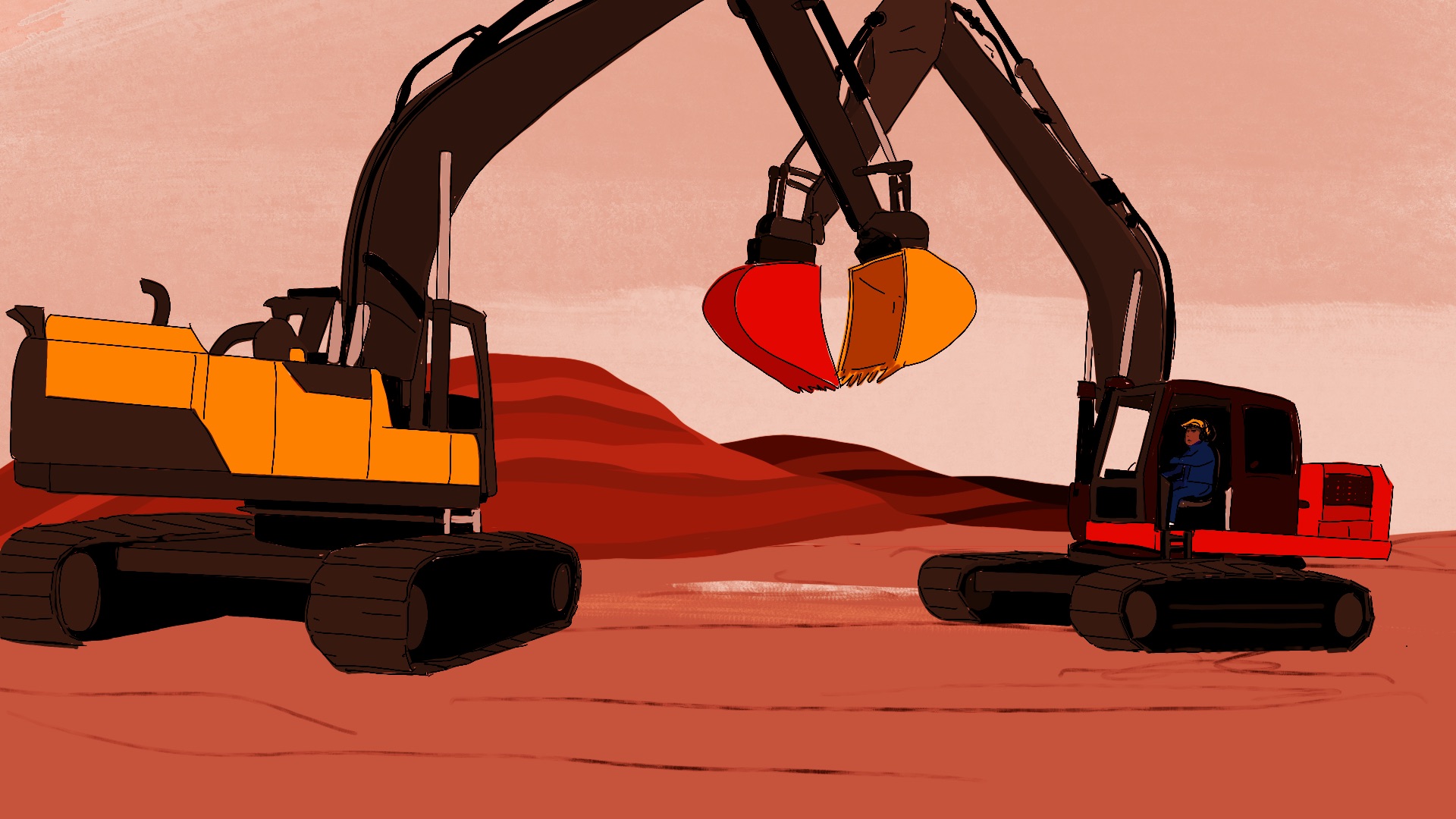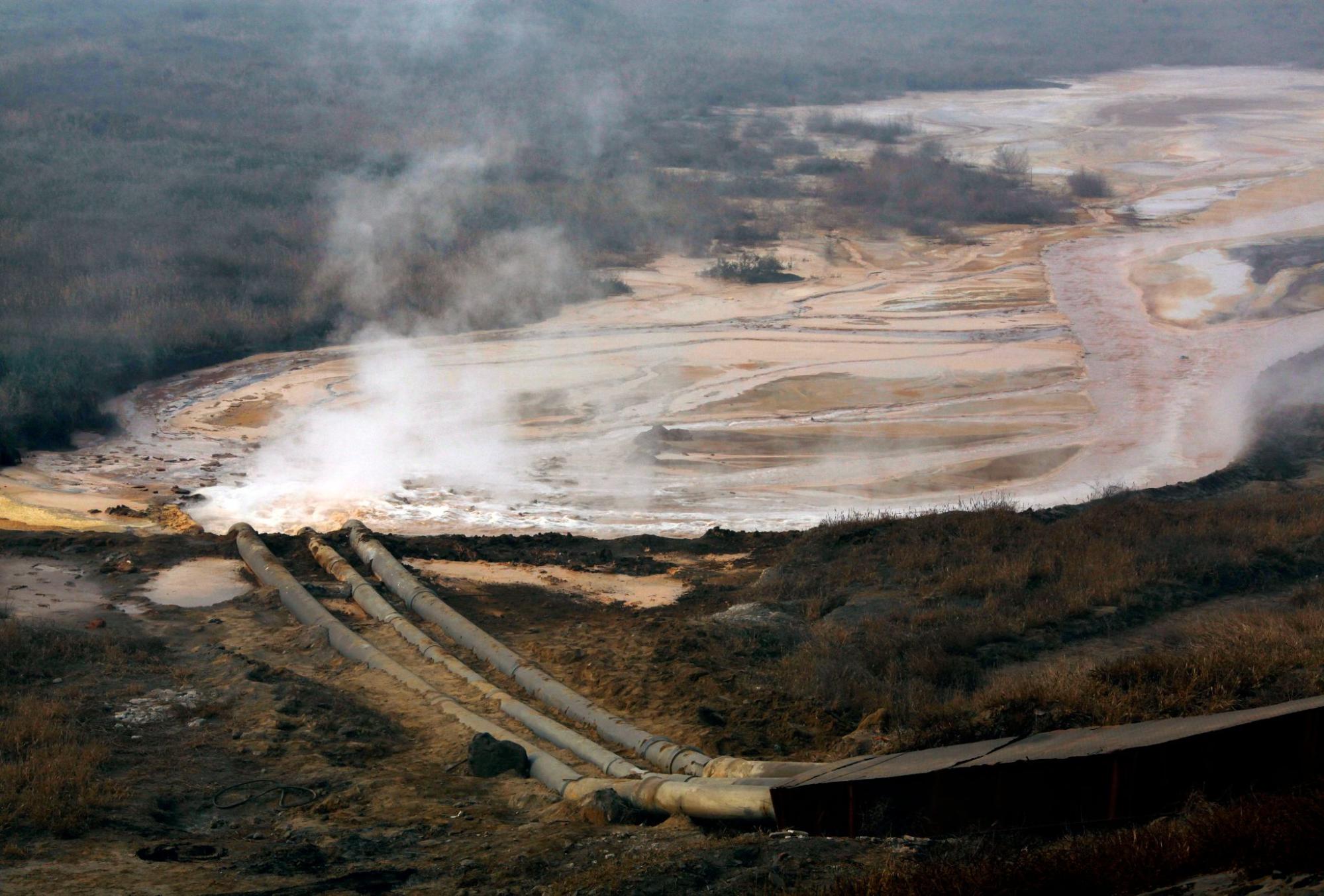
China dominates the mining and refinement of rare earths, which are needed for almost all of the electronic devices that power our 21st-century lives. But contrary to popular perception, China neither can nor wants to weaponize the global supply.

Eighty-five miles east of El Paso, the global contest for technological supremacy sounds like the din of diesel engines. Beneath Round Top Mountain, five thousand feet above sea level, in Hudspeth County, Texas, lies one of the largest concentrations of rare earth deposits in the United States. The Round Top Project, as it is called, has inspired additional mining efforts in places such as Alaska, Colorado, Wyoming, and Western Australia. They exist because countries around the world, from the U.S. to Japan to the E.U., are seeking their own metallic ores independent from the world’s largest producer of rare earth metals: China.
As tensions between the U.S. and China rise, rare earths have come to represent the China threat in sedimentary form. Beginning in the reform and opening-up era, the story goes, Chinese industrial policies and underhanded market tactics snatched the rare earth industry from the U.S. Now China is cashing in by “holding the world hostage” with its rare earths; it “flexed its muscle” with an embargo amid a maritime dispute with Japan in 2010; and, ultimately, it enjoys a powerful bargaining chip in future dealings with the United States. For the U.S. government, rare earths are the hand grenade in China’s arsenal to revise the liberal order.
The Biden administration’s solution has been to supercharge a decades-long effort to develop the domestic rare earths supply chain as a matter of national security. But the truth is that countries aren’t exactly competing for rare earths. Rare earths are not rare. One of the world’s richest deposits, Mountain Pass, is in California. And China, which has begun to import more rare earth concentrates than it exports, has been working on its own efforts at diversification. Difficult to produce, environmentally messy, yet essential for modern economies, rare earths, and their mining, exhibit the telltale signs of an international cooperative venture. Why, then, do they remain locked in a web of geopolitical falsehoods?
Part of it is the details we choose to talk about. In 1992, in an oft-quoted line, Dèng Xiǎopíng 邓小平 said that “the Middle East has oil; China has rare earths.” The sentence has gripped the internet and is used repeatedly to signal China’s own geopolitical calculations. But the words, uttered a year after the Gulf War, were not actually a boast, but a warning: Just as the Middle East could be a victim of the West’s resource-addled power games, so too could China.
Today, rare earth mining — from the Amazon to the deep sea to the arctic to the moon — recalls the extractive exploits of 19th-century Western imperialism. Rare earth references — the “nuclear option” or “the new oil” — evoke the language of 20th-century American power. To see rare earths as inexorably tied to this era’s great power competition is to be reminded of America’s own habits and predilections. After the U.S. weaponized its technologies during the apogee of the trade war, there was no “tit-for-tat,” despite much speculation that China could retaliate with its rare earths. The reason, quite simply, is because China is not the United States. If there is one lesson the rare earths issue imparts, it is that under the shadow of a rising other, a paranoid power can conjure its own demons.

Rare earths and export bans
Rare earths, a group of 17 metals near the bottom of the periodic table, are to industry what vitamins are to people. Found in everything from renewable energy generation to electric vehicles to network infrastructure and military weapons, they make everything faster, lighter, and stronger.
The metals entered the global lexicon circa 2010 in the heat of a frenzied diplomatic feud between two Asian powers. That fall, a Chinese trawler captain crashed into a Japanese coast guard ship off the coast of the contested Senkaku/Diaoyu Islands. In the heat of the moment, China issued a moratorium on rare earth exports that sent the global supply chain into a tailspin. “We got nailed,” Mitch Spencer, president of Polaris Rare Earth Materials in Indiana, told me recently. “The price of neodymium went from $45/kg to $450/kg.”
Ever since, rare earths have triggered insecurities in the West, both real and imagined. When the Taliban overtook Afghanistan last month, reports of rare earth deposits in the country prompted immediate chatter over China’s future involvement. Despite the particularities of the 2010 incident, it has become perfect fodder for the fatalist. “If China consolidates its position and maintains a long-term monopoly [on rare earths],” warned political scientist Steve Dobransky in 2013, it has the potential to “bring down America…as well as the rest of the world.” Rare earth bans were a pretext for war in the 2012 first-person shooter game Call of Duty: Black Ops II, and featured as a plot point in the Netflix political drama House of Cards in 2014.
Countries aren’t exactly competing for rare earths. Rare earths are not rare.
That is not to say that a Chinese export ban on rare earths should be taken lightly. The U.S. ban on semiconductors last year choked Chinese electric vehicle manufacturers and electronics giants like Huawei, which was knocked from its position as the world’s No. 1 mobile phone producer. A rare earth rejoinder would have a much wider, reciprocal effect. It could stifle the U.S.’s clean energy ambitions, halt much of the American auto industry, and knee-cap America’s defense systems. (In a 2016 study, 66% of Department of Defense vendors said they relied on imported rare earths.) “You think the semiconductor shortage at the moment is bad, wait till there’s no rare earths coming out of China,” said Jeff Wilson, a trade expert and director at the Perth USAsia Center.
But rare earths are not a zero-sum game. According to the geographer Julie Klinger, author of Rare Earth Frontiers, China’s share of global production is, in fact, on the wane. In 2018, it became a net importer of some rare earths, an action necessitated out of concern with issues of resource conservation, supply chain stability, and the environment — things the West should be worried about too.
Klinger, an assistant professor at the University of Delaware, told me recently that “the really tragic thing about all this geopolitical bluster is that rare earths are one of the handful of areas where the U.S. and China have directly complementary interests. China does not want to be responsible for supplying the whole rest of the world with rare earths.” Yet so long as Chinese hawks and state tabloids parade the prospect of weaponizing China’s rare earth supply, much of the world remains on edge about a set of metals they really don’t understand.

How the U.S. “dropped the ball”
In the minds of many U.S. politicians and analysts, China is the familiar antagonist in the rare earths competition. According to a Congressional Report in 2011, it was China that “gradually transferred the entire American rare earth industry overseas.” But as Klinger reveals in Rare Earth Frontiers, American policies and actors have had a strong hand. At the highest level, the Thatcher-Reagan era saw a renewal in the private sector’s commitment to profitability above all else, and businesses scoured the globe to find the ideal mix of lax environmental regulations and low-cost labor. Rare earths followed the same trajectory, and China was open for business.
The environmentalist Edward Nixon played a pivotal role in this transition. In the 1980s, the Mountain Pass mine in California, which had been responsible for 70% of the world’s rare earths supply, began a piecemeal move to China due to concerns over environment and cost. “He was very much interested in preserving ‘America the Beautiful,’” Klinger said on The China Project’s Sinica Podcast. “And the way you do this is by exporting dirty industry, and he happened to be well-connected in China.” In 1970, on his behest, his brother — Richard Nixon, who happened to be president at the time — established the Environmental Protection Agency, ushering in a raft of new policies that bogged down rare earth ventures. But Klinger believes the policies worked exactly the way they were intended, pitching America’s dirtiest jobs overseas so it could evolve into a high consumption and service-oriented economy.
Throughout the 2000s, China outsourced the mining portion of its rare earth business. From its peak of 98% in 2010, the country now produces as low as 63% of raw rare earths.
The dismantling of Magnequench, the last American producer of neodymium magnets, was what the 2011 Congressional Report later called “the last act” in China’s capture of America’s rare earth sector. But as Spencer, a Magnequench employee prior to founding his own company, recollected, responsibility fell on both sides. “There were interested parties in China that wanted to invest [in the company], but they didn’t really know how to go about doing it — so they enlisted help,” he said. Help came in the form of an investment banker named Archibald Cox Jr., the son of the renowned Watergate prosecutor.
As the CEO of an investment bank, Cox bought the magnet maker, the last of its kind, and began selling it piecemeal to China throughout the early aughts. He closed one plant and sent it overseas in 1998, then another in Idaho in 2000; the last plant closed in Indiana in 2003. An organizer with the Indiana workers union at the time called Cox a “traitor to his country,” his deals amounting to “a criminal act.” (Congress demanded a review of the takeovers, but the process stalled from a lack of resolve.) Around the same time, Wilson, who had been following China’s rare industry closely for years, noted that the U.S. government began selling off its rare earths stockpiles after the Cold War; they flooded the market, depressing prices and deterring new entrants. The result was a total internal collapse. “The Americans just dropped the ball and walked away,” he told me.

How China became a leader in rare earth production
In 2017, the Trump administration deemed China a “revisionist power,” and government reports began describing China’s rare earth policies as instances of “economic aggression” — alongside intellectual property theft and currency manipulation. But as Wilson explains, “No one [in China] was thinking in 30 years’ time we were going to have a dagger in the artery of the global ecosystem.” Rather, at the time of China’s purported heist, the country was barely out of the Cultural Revolution. The country lagged far behind in key technologies, and rare earth processing required a deep level of technical knowhow. Like most technology sectors in the post-Mao era, Chinese state policies began not out of “aggression,” but an acute desire to play catch-up.
In the 1980s, China’s interest in rare earths stemmed from its perceived value in the nascent computing and electronics industry. “This was something that China had and could contribute to a competitive advantage in emerging personal computers,” Wilson told me. The one who had helped China single-handedly break through the technological barrier was the chemist Xú Guāngxiàn 徐光宪, known as “the father of rare earths.” In 1951, Xu returned to China after completing a PhD in Chemical Engineering at Columbia University. He had been asked repeatedly to stay for a teaching job but refused out of a sense of patriotism. “Science knows no borders,” he said, “but scholars have their own country.”
In the 1950s, China was rich in rare earth deposits but impoverished in the tools to use them. A Xinhua report said that “China could only export rare earth concentrates at low prices and import them back at a markup.” In the following decades, Xu worked ceaselessly with the government to build up the infrastructure to “reverse the backwardness of China’s rare earth industry.” He devised over a hundred chemical formulas related to rare earth separation and taught a generation of Chinese metallurgists who are now leaders in their field.
“Outside of China, you don’t have many human beings who have training in rare earth hydrometallurgy,” Wilson said. “The number of hydrometallurgists with PhDs globally now would be less than 20.”
In 1990, after the balance of trade had already begun to reverse, the Chinese government declared the resource a “protected and strategic mineral.” Xu was paraded by state media and has won accolades delivered by President Xí Jìnpíng 习近平 himself. But China didn’t achieve its current position in the rare earth sector alone. State subsidies helped, and favorable geography was a prerequisite, but it was ultimately the West that willingly ceded the catbird seat.

Modern ambitions
What does China want with its rare earths now? According to Dudley Kingsnorth, an Australian rare earth consultant, China wants to move up the value chain. “France will sell you a bottle of wine, but it won’t sell you grapes,” he told the Sydney Morning Herald last summer. China has sought to control more of the downstream processing to feed its ambitions in selling end products such as electric vehicles and mobile phones to the world. All of this requires a shift away from mining toward the kinds of metallurgical experts Xu trained through the 80s and 90s.
But the departure from mining is equally a bid for less environmental destruction and more resource conservation. In the Twelfth Five-Year Plan, in 2011, officials emphasized the need to protect and strengthen existing rare earth reserves because the costs of extraction have begun to outweigh the benefits. From 1990 to 1997, the cancer mortality rate in the gusty Inner Mongolian steppes of the Bayan Obo mining district, where most of the global supply of rare earths resided, rose 50%. The three leading causes of death in the area were cancer, unspecified poisoning and accidents, and infant mortality. Baogang Tailings Dam, where waste from the refining process collects, has grown since the late 1950s to the point where it has been dubbed the “world’s dystopian lake.”

Throughout the 2000s, China outsourced the mining portion of its rare earth business. From its peak of 98% in 2010, the country now produces as low as 63% of raw rare earths. By some estimates, it now imports more rare earth concentrates than it exports. According to Adamas Intelligence, about half of China’s feedstock of heavy rare earths come from Myanmar, with the rest coming from other Southeast Asian countries such as Malaysia and Vietnam.
As China’s reserves dwindle, it has sought help from beyond its borders. Yáo Jiān 姚坚, a former top official in the Ministry of Commerce, expressed the sentiment most clearly in 2010. At a Government Economic Working Committee in December, he told members that the maintenance of the international rare earth supply was “the common responsibility of countries around the world.” He continued: “I hope other countries will further the development of rare earth resources.”
China has backed those words with deeds. It was under Chinese leadership that the first effort at collective problem-solving for rare earth elements began in 2016, through the International Organization for Standardization (ISO). Disparate parts of China’s government have also attempted to globalize the extraction of rare earths for years under the Belt and Road Initiative. Chinese officials conduct geological surveys with partner states and conduct geological collaboration particularly with researchers in Central and Southeast Asia. Beijing has even supplied countries with its expertise. A Malaysia mine owned by the Australian miner Lynas Corporation benefited from consulting Chinese metallurgists. And, not least of all, China has supplied copious amounts of capital. Shenghe Resources, China’s rare earth giant, has taken minority stakes in several mines across the world, along with projects in the U.S., Vietnam, Greenland, and Australia. It owns an 8% stake in MP Minerals, the U.S. miner that operates the Mountain Pass mine (ironically re-opened as a buffer to “the China threat”).
“This is framed in English media as totally nefarious,” Klinger points out. Shenghe’s minority stake in MP Minerals has indeed irked U.S. government scientists and analysts. Its investment “maintains and even heightens U.S. vulnerability,” James Kennedy, president of the rare earth advisory Three Consulting, told Quartz. China’s investment in global mines has even been cited by Trump’s Department of Defense as evidence for, rather than against, China’s “economic aggression.”

Tech competition on a safer floor
That collective problems, like rare earth mining, are recast in the discolored light of geostrategy is not an exception to our age; it is, in many ways, its very condition. It happens chronically on climate, when countries jostle to reduce their proportional burden. But it also happened spectacularly with COVID-19, when the U.S. chose to develop and distribute vaccines alone, snubbing international coordination through the United Nations’ Covax initiative. It is striking that in these cases, as with rare earths, China extends its hand across the aisle more than the U.S.
This is not to say that China’s actions are altruistic: a stable supply of rare earths outside China helps fuel its quest to dominate electric vehicles and consumer electronics. But at its core, the country’s efforts align with the rest of the world’s desire to wean themselves off Chinese metal. “What’s driving this is a real concern with avoiding the destabilizing effects of a global shortage,” Klinger told me. Technology competition is inevitable, but it need not come at the cost of the earth and its inhabitants. To ensure a stable supply of a critical good is to make sure great power competition occurs on a safer floor.
“Rare earths are one of the handful of areas where the U.S. and China have directly complementary interests. China does not want to be responsible for supplying the whole rest of the world with rare earths.”
In the coming years, China will continue to ramp down rare earth mining. At the United Nations last September, Xi Jinping committed China to peak emissions before 2030 and to achieve carbon neutrality before 2060. As carbon emissions targets become more ambitious, rare earth production will slow. “Over the last five years, we’ve seen that shift to reduce the emissions, keeping cities clean and all that,” said Kwasi Ampofo, head of metals and mining research at BloombergNEF. “And the next five years, too, we have seen that aggressive push where the government is talking about attaining peak production for most of these metals simply because it has to meet its emissions reduction targets.”
Yet China’s role as the bogeyman in the West’s rare earth debates remain. In March, the Department of Energy issued a $30 million initiative for research to secure America’s rare earth supply chain. Last week, a bipartisan House bill offered tax incentives to revitalize America’s rare earth magnet manufacturing. The Biden administration, which examined the rare earth issue promptly after taking office, uses China the same way Trump once did: as a distraction from internal sources of dysphoria. In a divided government, China unlocks policy options otherwise foreclosed by a dysfunctional politics.
In fact, China was never the main source of the West’s rare earth problems. Just as the 1980s and ’90s saw laissez faire governments export dirty industries overseas for profit, the 2000s and 2010s saw divided governments do away with industrial policies as a matter of principle. Wilson, in his own consultative work, noted the change when advocating for a rare earth industry in his home country of Australia. “We’re asking the Australian government to use a policy lever that the whole ideology of the Australian government now says they don’t do,” he told me. “Someone like me has to then come in and say, ‘Well if you don’t do it, you’re not gonna get it.’”
From the Belt and Road to the Middle East to rare earths, the world tends to overstate Beijing’s quest for gain, while underselling its desire to avoid loss. For China, a country obsessed with win-wins, a rare earth embargo would truly be lose-lose. “There’s a lot of interdependencies that go on here, so we shouldn’t simplify the message,” said BloombergNEF’s Ampofo. “China also relies on other countries at some levels of the supply chain, so it would never be so simple to initiate a blanket export ban.”
With all the attention pinned on China’s hawks these days, it may be the prudent ones, those who aren’t seeking the spotlight, who get it right. In 2019, at the height of the trade war, Lǐ Péngdé 李朋德, a member of the CPPCC Standing Committee and Deputy Director of the Ministry of Natural Resources’ China Geological Survey, gave a lecture (in Chinese) to the Chinese public on the topic of rare earths. When an audience member asked Li to comment on the online campaign to weaponize China’s rare earths, Li paused and faced the crowd with resolute calm. Then he invoked Deng’s analogy to Middle Eastern oil. “Has any country ever barred oil to the rest of the world?” he asked, rhetorically. “It’s impossible. Rare earths are the same.”






